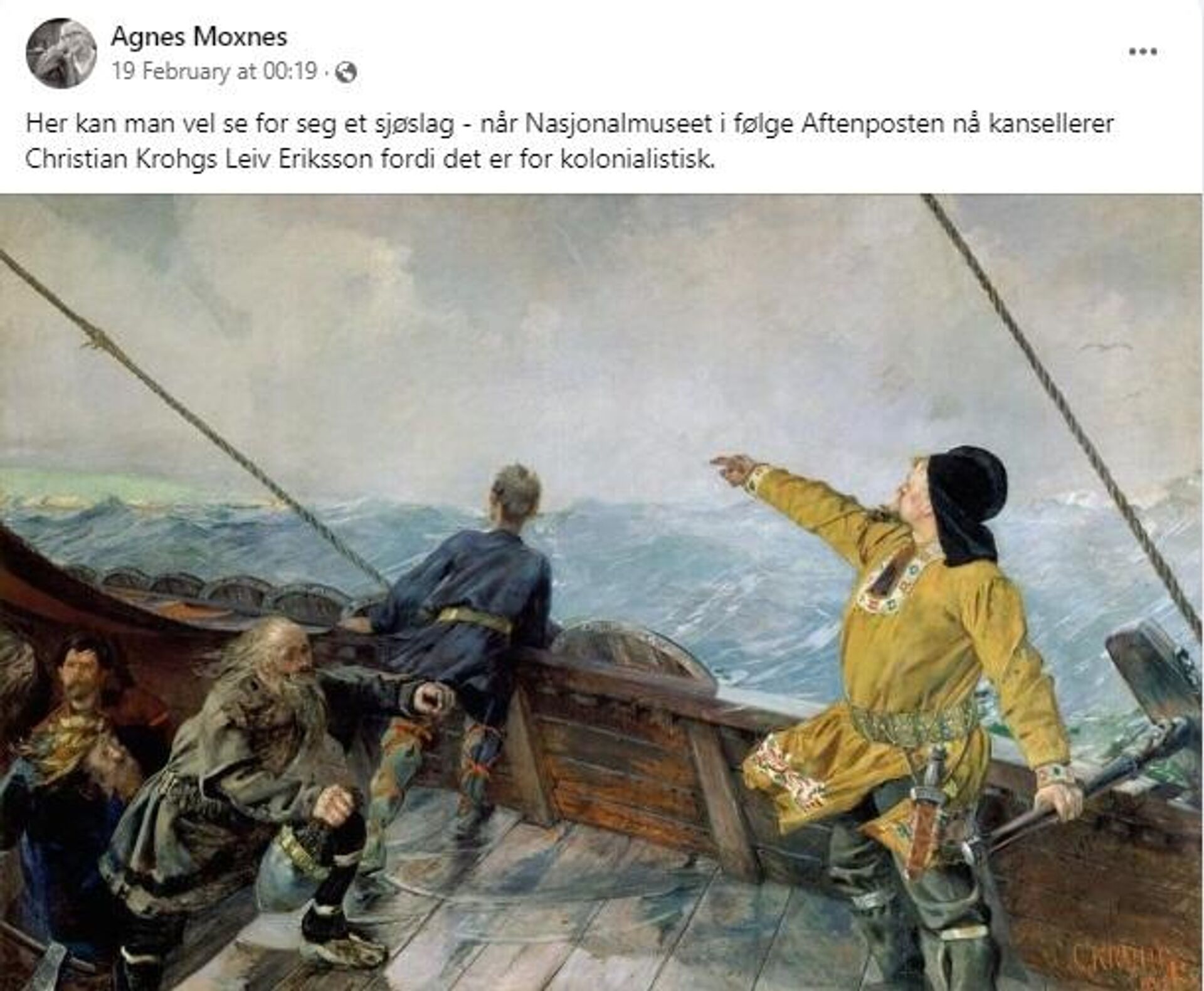https://sputnikglobe.com/20230221/norwegian-museum-drops-classic-painting-of-americas-discovery-as-colonialist-1107647126.html
Norwegian Museum Drops Classic Painting of America's Discovery as 'Colonialist'
Norwegian Museum Drops Classic Painting of America's Discovery as 'Colonialist'
Sputnik International
The decision to remove a classic 19th-century painting of Viking voyages as "romanticization of colonialism" was slammed as "ahistoric," "frightening" and tantamount to censorship.
2023-02-21T06:17+0000
2023-02-21T06:17+0000
2025-04-07T11:06+0000
art
scandinavia
news
colonialism
norway
vikings
viral news
https://cdn1.img.sputnikglobe.com/img/07e6/0a/0b/1101705184_0:94:3073:1822_1920x0_80_0_0_51dbc4dd7397818bd9e00a6724359845.jpg
The Norwegian National Museum in Oslo has landed in hot water by its recent move to demote a classic painting by Christian Krohg depicting the Viking discovery of America into the basement.Krohg's "Leif Ericsson Discovering America" from 1893, was received as a gift from Leif Erikson Memorial Association in Chicago in 1900 and adorned the museum's staircase until deemed "colonialist" by its authorities.It shows a group of Viking seafarers, who are thought to be the first Europeans to discover North America around the year 1,000, after crossing the Atlantic ocean in their longships. In doing so, they formed a short-lived settlement named Vinland."The picture is a romanticization of Norwegians who went to America. It is a colonialist image," National Museum department director Stina Högkvist told Norwegian media, justifying the move that immediately sparked a hot debate over what many interpreted as unacceptable censorship, devoid of history.Art historian and author Tommy Sorbo called this move "both ahistorical and frightening."Politician Mimir Kristjansson of the Reds Party argued that neither the painting nor the image were colonialist. Furthermore, he stressed the necessity to "endure" historic images that don't necessary meed the moral and politically correct standards of the 2020s.Art critic Agnes Moxnes slammed the move as ill-advised.Writer Fredrik Horn Akselsen called Krohg, who was inspired by the realism art movement and often chose motifs from everyday life, a "free-spirted humanist" who fought against poverty, for social reforms and equality. Krohg also served as the director and the first professor at the Norwegian Academy of Arts until his death in 1925.However, Christian Krohg's famous painting is not the only artwork that has ended up in the basement. The same fate was shared by other classics that no longer fit into the museum's "updated profile."According to department director Stina Högkvist, as part of its modernization, the museum wants to challenge a standard that has historically been represented by white, male artists. In doing so, she pledged to show "more female artists, more [indigenous] Sami artists and more art by people who happen be born with skin other than white," calling for a "socially relevant, fresh look at art history."
https://sputnikglobe.com/20211020/no-offence-christopher-vikings-reached-new-world-long-before-columbus-new-study-claims-1090078740.html
scandinavia
norway
Sputnik International
feedback@sputniknews.com
+74956456601
MIA „Rossiya Segodnya“
2023
News
en_EN
Sputnik International
feedback@sputniknews.com
+74956456601
MIA „Rossiya Segodnya“
Sputnik International
feedback@sputniknews.com
+74956456601
MIA „Rossiya Segodnya“
classical art, canceled art, "colonialist" attitudes, america's discovery, viking voyages
classical art, canceled art, "colonialist" attitudes, america's discovery, viking voyages
Norwegian Museum Drops Classic Painting of America's Discovery as 'Colonialist'
06:17 GMT 21.02.2023 (Updated: 11:06 GMT 07.04.2025) The decision to remove a classic 19th-century painting of Viking voyages as "romanticization of colonialism" was slammed as "ahistoric," "frightening" and tantamount to censorship.
The Norwegian National Museum in Oslo has landed in hot water by its recent move to demote a classic painting by Christian Krohg depicting the Viking discovery of America into the basement.
Krohg's "Leif Ericsson Discovering America" from 1893, was received as a gift from Leif Erikson Memorial Association in Chicago in 1900 and adorned the museum's staircase until deemed "colonialist" by its authorities.
It shows a group of
Viking seafarers, who are thought to be the first Europeans to discover North America around the year 1,000, after crossing the Atlantic ocean in their longships. In doing so, they formed a short-lived settlement named Vinland.
"The picture is a romanticization of Norwegians who went to America. It is a colonialist image," National Museum department director Stina Högkvist told Norwegian media, justifying the move that immediately sparked a hot debate over what many interpreted as unacceptable censorship, devoid of history.
Art historian and author Tommy Sorbo called this move "both ahistorical and frightening."
"It is classic censorship and it says that you are not mature enough for this picture," he told Norwegian media. "Rembrandt, Caravaggio, Michelangelo. Down in the basement with it. Censorship, censorship." He emphasized that it is a-given that works of art carry with them the attitudes and ideologies of their time. "We're not that stupid that we don't see through it as an audience," he concluded.
Politician Mimir Kristjansson of the Reds Party argued that neither the painting nor the image were colonialist. Furthermore, he stressed the necessity to "endure" historic images that don't necessary meed the moral and politically correct standards of the 2020s.
Art critic Agnes Moxnes slammed the move as ill-advised.
"We are talking about a national museum, with all it entails. In means the national icons should be highlighted. Feel free to discuss them. But jumping straight to the 'colonialist' argument and taking it down that's really unwise!" she wrote on social media. Moxnes also mused that it's not the National Museum's task to censor or cancel art.
Writer Fredrik Horn Akselsen called Krohg, who was inspired by the realism art movement and often chose motifs from everyday life, a "free-spirted humanist" who fought against poverty, for social reforms and equality. Krohg also served as the director and the first professor at the Norwegian Academy of Arts until his death in 1925.

20 October 2021, 17:56 GMT
However, Christian Krohg's famous painting is not the only artwork that has ended up in the basement. The same fate was shared by other classics that no longer fit into the museum's "updated profile."
According to department director Stina Högkvist, as part of its modernization, the museum wants to challenge a standard that has historically been represented by white, male artists. In doing so, she pledged to show "more female artists, more [indigenous] Sami artists and more art by people who happen be born with skin other than white," calling for a "socially relevant, fresh look at art history."



